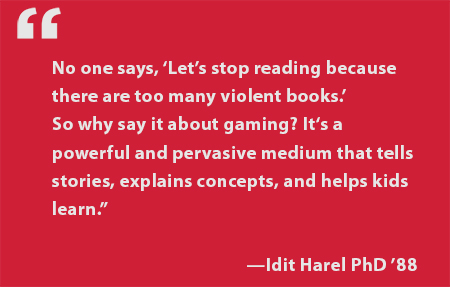How Do You Connect Education and Gaming? Bring Gaming into Education
-
-
slice.mit.edu
- 1
Filed Under
Recommended
 New media entrepreneur Idit Harel PhD '88 spoke to Slice of MIT
New media entrepreneur Idit Harel PhD '88 spoke to Slice of MIT
There are 55 million K–12 students in 132,000 schools in the United States. Ninety-seven percent play video games. Many people see gaming as the enemy of education—an unproductive time-waster filled with violent images and unsavory themes.
“No one says, ‘Let’s stop reading because there are too many violent books,’” says Idit Harel PhD ’88. “So why say it about gaming? We need to understand this medium better and develop capabilities and literacies around it. Gaming is a powerful and pervasive tool that tells stories, explains concepts, and helps kids learn.”
Harel’s quest for gaming literacy led her to create Globaloria, a programmable game-making platform that teaches young learners STEM skills like software engineering and coding. The platform teaches students how to build video games through teacher-based instruction and hands-on learning.
“Playing games and apps are not enough—no one’s fully literate until they learn how to write them,” she says. “Of the 97 percent who play, not all are digitally literate. So how do we make them critical thinkers and computationally fluent? Through coding—we teach them how the games are made.”
 Since 2006, more than 800 educators in 180 schools in 14 states have integrated Globaloria into their curriculum. And more than 17,000 students have built games like “English in Action,” “Save Me,” and “Puny Pestilent Problematic Parasites.”
Since 2006, more than 800 educators in 180 schools in 14 states have integrated Globaloria into their curriculum. And more than 17,000 students have built games like “English in Action,” “Save Me,” and “Puny Pestilent Problematic Parasites.”
“Our platform is focused on a central theme—encouraging students to create technology, not just use it,” Harel says. “Designing and engineering video games is the new literacy, coding is the new writing, and games are the lure.”
Harel spoke to Slice of MIT at the 2015 South by Southwest (SXSW) Interactive festival, where she was part of a panel organized by the U.S. Office of Educational Technology on gaming and coding as entry point for teaching real-world skills. Globaloria also hosted the White House-sponsored Austin Education Game Jam during SXSW, a workshop and contest for game developers to create commercially-viable and education-focused video games. Harel was one of more than 100 MIT alumni who presented at the festival.
“Not all of us become writers, poets, or journalists, but we become literate learners by both reading and writing,” she says. “It’s same with digital media. Playing and making games is fundamental to teaching and learning in a digital world.”
 Most important, mastery of computational and coding literacy carries real-world implications for the future workforce. STEM-related fields will soon account for nearly 8 million unfilled U.S. jobs but only nine states list computer science as a requirement for a high school diploma and less than 4 percent of U.S. schools offer computer science and coding in their curricula.
Most important, mastery of computational and coding literacy carries real-world implications for the future workforce. STEM-related fields will soon account for nearly 8 million unfilled U.S. jobs but only nine states list computer science as a requirement for a high school diploma and less than 4 percent of U.S. schools offer computer science and coding in their curricula.
“Our research shows that there’s talent in every zip code,” she says. “But we need to cultivate innovation skills. Having engaging STEM content should be a requirement in all K-12 schools.”
Harel’s learning-through-gaming mindset dates back 30 years when she part of the MIT Media Lab’s first-ever cohort. In 1989–1990, she received funding from Nintendo and the National Science Foundation to study the power of kids learning computer programming and her book, Children Designers, won the 1991 Outstanding Book Award from the American Education Research Association.
“The Media Lab’s perspective from the beginning was to construct imaginative applications, learning environments, and creative tech demos for new knowledge representations and new ideas for the future,” she says. “At MIT, we learn to design, invent, and engineer technologies to solve the world’s problems. I want all kids to learn just that. And games help, too.”








Comments
Bruce
Mon, 01/04/2016 1:09pm
This is an interesting take. I've been working on incorporating social media in education, but it's never really occurred to me that there may be a place for gaming too.
It does make perfect sense to have gaming, especially virtual reality type games as an educational resource. Of course the technology is not quite there yet. For some reason the Matrix and I know Kong fu comes to mind. Now that would be useful.